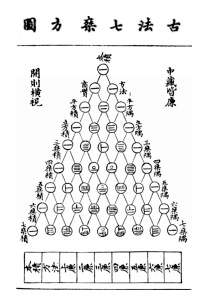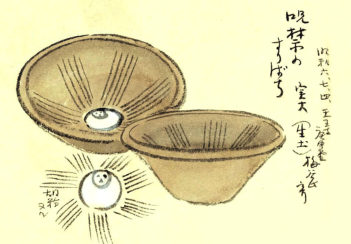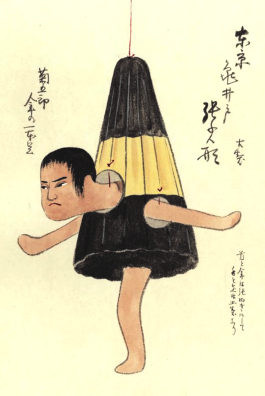Commenting problem fixed
Sorry for the inconvenience. Thank you, random online .htaccess tutorial.
Sorry for the inconvenience. Thank you, random online .htaccess tutorial.
Short poem entitled "Stilts" (Takeuma, 竹馬, literally "bamboo horse") by ŌKI Atsuo (大木 惇夫):
Tonari no kora ga
Ura no yabu kara kitte tsukutta
Kono takeuma no take no aosa yo,
Osanai hi no omoide ni
Shimiiru yō na sono aosa yo.
Cut by the children next door
From the thicket out back to make
these stilts: o greenness of that bamboo,
Bleeding into my youthful
memories, o greenness.
"Takeuma" is a nice illustration of how Japanese poets exploit left-branching. The ideas in the first few lines appear in this order: Next door, children, out back, thicket, cut, made, stilts, bamboo, greenness -- and everything before "greenness" is one big modifier. A natural English equivalent, if you weren't concerned about retaining the structure, would be "O greenness of the bamboo of these stilts that the children cut from the thicket out back."
In the Japanese literary tradition, ideas emerge from the primordial general as an amorphous blob, and then slough off layer upon layer as they stumble forward until at last a core of specificity is revealed -- although, this being Japan and all, the final reveal is optional if it seems obvious enough. This tends to draw criticism from folks from "specific-to-general" cultures, but it works beautifully as a way to build tension and setting the scene before unveiling the subject of a poem.

That Bakushō Mondai boke ŌTA Hikari should call NEETs who blame their NEEThood on social trends "spoiled brats" (amattare) is not surprising or even news, really -- although it is Itai News, for obvious reasons. What I want to write about is the theme of the debate: Ware hataraku yue ni sachi ari? (我働く、ゆえに幸あり?).
An idiomatic translation of this would be "I work, therefore I am happy?" -- it's a slightly awkward variant of one of the oldest and most international snowclones in existence.
The standard Japanese translation of Descarte's Cogito, ergo sum (or Je pense, donc je suis) is Ware omou, yue ni ware ari. Note the pseudo-kanbun tone, for authority, like . Note also that omou isn't necessarily the best verb to use -- internet people and respected philosophers alike have mounted cases for kangaeru instead. The objection is that omou is really closer to "feel" (subject = perceiver), while kangaeru is more like "cogitate" (subject = effector/agent).
But that's just too bad. Omou it is and omou it shall ever be.
One more observation: because the original Japanese phrase is "... ware ari" ("I exist"), you can substitute in "... sachi ari" ("happiness exists" → "I am happy") without defusing the power of the final verb the way the "I am" → "I am X" change does in English.
Here is a poem written in Chinese by Ikkyū, from the Kyōun shū (狂雲集, "Crazy Cloud collection"). The title is 乱中大嘗会, "Wartime combined-harvest-and-emperor-confirming-ceremony". (Daijōe: hard to translate.)
当今聖代百王蹤
玉体金剛平穏容
風吹不動五雲月
雪圧難摧万歳松
Here is how YANAGIDA Seizan trots it in his translation of the KS, published by Kōdansha in their "Classics of Zen" (禅の古典) series:
当今、聖代、百王の蹤、
玉体は金剛のごとく、平穏の容。
風吹けども動ぜず、五雲の月、
雪圧せども摧き難し、万歳の松。
Romanized:
Tōkon, seidai, hyaku-ō no ato,
Gyokudai wa shingō no gotoku heion no kao.
Kaze fukedomo dōzezu, go-un no tsuki,
Yuki osedomo kudakigatashi, banzai no matsu.
Translated as prose:
The present [emperor], his sacred reign, heir to a hundred kings,
His presence is like diamond, his visage calm.
Though the wind blows he is not disturbed: a moon among five-[colored] clouds,
Though the snow presses he does not break: a ten-thousand-year-old pine.
The emperor here was Tsuchimikado II, who was enthroned just before what turned out to be the Ōnin War. Given the likelihood of being killed more or less at random in those days, it isn't surprising that Ikkyū should have come out in favor of peace, stability, the good old days, and the hundred-odd emperors who presided over them. (And let's not forget that one of those emperors was Ikkyū's own father.)
Anyway, what I like about Yanagida's edition is that he also provides a translation into more poetic Japanese, using 7- and 5-syllable lines (give or take some hypermetricity):
今上天皇、百代うけた、
仁王のからだ、温和なひとみ。
風にも動かぬ、月のかげ、
雪にも折れぬ、千代の松。
Romanized:
Kinjō tennō, hyakudai uketa,
Ni-ō no karada, onwa na hitomi.
Kaze ni mo ugokanu, tsuki no kage,
Yuki ni mo orenu, chiyo no matsu.
In pentameter:
Our emperor, his line one hundred strong:
A Hercules in form, though mild of eye;
A steadfast moon, unmoved by any wind;
An ancient pine, unbending in the snow.
It isn't often you can make legitimate use of Hercules in a translation from Japanese, but I claim that right, because Herakles was the original inspiration for the game of iconographic telephone played down the Silk Road that ended in the "Deva Kings" (仁王) mentioned in the original. Go Indo-Europe!
C.: We only have two weeks left before the wedding ceremony... I guess I should start turning into Bridezilla.
Me: What? No! Bridezilla doesn't mean "a bride who prepares properly for her wedding", it means "a bride who makes everyone unhappy by being unreasonable about her wedding preparations". It's a bad thing.
C.: Okay, then, Bramera.
Over at META no TAME, I linked to the Ningyo-do bunko database of illustrations by KAWASAKI Kyosen (1877-1942) of toys, souvenirs, charms, amulets, etc. Here are a few more entries that I wanted to share.
First, dig this: a 呪禁 (jukin) mortar from Ōsaka.

Jukin is, as far as I can tell, a variant pronunciation of jugon, an old Taoism-based magical concept in which evil influences were forbidden (禁) via spells (呪) from afflicting the protected party or parties. I suppose the jukin mortar allows you to protect yourself from the evil eye and grind sesame at the same time. Efficient!
Next, an endearing fellow billed as "Kikugorō / One-legged umbrella":

I'm not sure whether Kikugorō is his name, brand name, maker's name or what, but he looks like a gritty revisioning of the karakasa umbrella monster, perhaps by URASAWA Naoki.
His head and torsumbrella are papier-mâché, but his limbs are ceramic -- for fighting! And also so that he doesn't blow around too much in the winds.
And finally, the dreaded ushi-oni ("cowgre") of Uwajima:

The ushi-oni is a monster with a cow's body, an oni's head, and a sword for a tail. No doubt it is quite terrifying in non-pantomime horse form. In Uwajima they don these things and charge around the streets for the Ushi-oni Festival, which also features non-fatal shoving matches between real cows.
This post is about HOSONO "Harry" Haruomi's "Hurricane Dorothy", one of my favorite 70s songs. If you ain't know, please consult this reference copy on YouTube. That's the album version, the album being 1975's Tropical Dandy, which was the first part of Hosono's "Tropical Trilogy" and, as it happens, an ancestral form of YMO's first album of electro-exotica goof-offs.
Summary of the content: Hosono outlines the many ways in which his woman is a hurricane (eyes like a Carib wind, lips like an Arabian darkness etc.) before whom he, in his capacity as a representative of tropical paradise, is blissfully, ecstatically helpless. Then we come to the chorus and he sings a bunch of phonetically pleasing nonsense: "Bolero, bolero, la-la-lu-la/ Odoru ("dance"), bolero, la-la-lu-la, laaa-lu-la", etc. Yeah, don't overthink it.
What else does YouTube have for us? How about a nice live version performed by Hosono and some other Tin Pan Alley members in the mid-70s, all of them looking totally bombed as was the style at the time. Being a live performance, it obviously lacks the uterine-lining lush production of the recording, but the (literally) heavenly stroll-pulse is intact, and handing all substantial guitar duties to HAMAGUCHI Motoya for flutation works out great. (More Tin Pan Alley dancing available here.)
Oh: I also found this black-and-white fauxnime tribute to "Hurricane Dorothy" by Wisut Ponnimit. I guess it's nice.
Hashi is a Japanese word meaning "edge" with two emphatic variations ("very edge"): hajikko and hashikko. Hajikko, the "voiced" version, seems to be more common in speech than hashikko, but why should this be the case when hashi's own voiced variant, haji, is so rare that I can't recall ever having encountered it in the wild?
I should probably admit up front that I didn't find a satisfactory explanation for this. The closest I came is a question at Yahoo! Chiebukuro hinting at an east/west divide: here on the eest side we say hajikko, out west they say hashikko, and there's one poster from Tottori representing hazukko. Well, hajikko does feel more Edo than hashikko...
While I was searching, I also found this great 2ch thread in which the participants snipe at the great unwashed (and, before long, each other) over usage -- "Osaka. Lots of people who say shuppai for shippai (mistake)" / "Nobody fecking says that, you tool" -- and talk about 『進ぬ!電波少年』 (Susunu! Denpa shōnen), a television program with a nonsensical name derived from its predecessor's『進め!電波少年』 (Susume! Denpa shōnen, "Onward, idiot boys!") by extending the loop on the め (/me/) to get ぬ (/nu/). Good times.
"Twilight of the examination results boards: More and more universities using internet for quick notification": an article in the Asahi that does exactly what it says on the box.
You see, traditionally, each university in Japan posted their entrance examination results publicly on campus: each applicant had a number under which they took the exam(s), and if your number was on the results board, that meant you had passed and therefore been accepted into the university. If it wasn't there, time to visit your safety school.
(The appropriate telegrams to send to your folks in the country were SAKURA SAKU ["the cherry blossoms bloom"] and SAKURA CHIRU ["the cherry blossoms fall"] respectively.)
Since there's no technical reason why making a list of numbers public can't be done online, many universities (including more than half of all private institutions, according to the Asahi) are now doing just that. The article includes a picture of Nara Women's University's online results board on a cellphone screen, for those unable to picture what numbers might look like on the internet.
(Having said that, I can only find PDFs on Nara WU's non-cellphone homepage, so I guess they really did fail to devise a scheme for putting a list of numbers online. Awkward!)
Of course there are some institutions who have no intention of changing procedures. "For the students who have worked hard to get there, it's a once-in-a-lifetime scene of drama and intense emotion," says University of Tokyo entrance exam group head WATANABE Shōzō. "We think it's important [to preserve it]."
Meanwhile, Blenda magazine's top headline this month: "Glam, I'm home". Hmm.
"Is Glam my house?" wonders random woman I found via Google Shiori. To me it sounds more akin to "Honey, I'm home", making Glam my wife.
In memory of Gary "Dungeons & Dragons" Gygax, I thought it might be nice to take a look at the history of D&D in Japan.
Wikipedia's delightful article divides D&D's Japanese history into four ages: "Pre-Translation", "Shinwa", "MediaWorks", and "Hobby Japan". The Pre-Translation Age was one of truly legendary nerdery -- men and women without internet connections of any kind, importing at great expense books in an foreign language and studying the rules they contained for pretending to be an elf. Their cyclopean achievements make the otaku of today look like keg-chugging frat boys. This golden age lasted from the dawn of D&D in the mid-70s until 1985, when Shinwa ushered in the twilight of the ur-nerds by releasing the first Japanese edition of the game.
The Ages of Shinwa lasted almost a decade, and is now remembered fondly for its bloopers: "plutonium pieces" for "platinum pieces", "reggae armor" for "leather armor" (i.e. ゲ→ザ, an easy enough error for a typesetter to make). This was also the period when HAGIWARA Kazushi threw a Beholder into his manga serial Bastard!!, but had to give it limbs and rename it SUZUKI Dogezaemon for the trade.
The Shinwa Empire was reportedly brought low following a miscalculation on its part regarding the willingness of Japan's gamers to switch to Advanced D&D, and it was three years later in 1994 that MediaWorks seized control of the property. The keystone of their localization effort was YASUDA Hitoshi of Group SNE -- anime nerds will recognize them as the force behind Record of Lodoss War, which began as a humble transcript or "replay" of their D&D campaign. This was to be a localization by RPG nerds for RPG nerds, but, alas, it was up against an implacable enemy: Japan's late-90s "Winter Age of Tabletalk RPGs", a market contraction now generally attributed to post-Bubble malaise and competition from computer games.
We the living find ourselves in the Age of Hobby Japan, playing 3rd or 3rd-and-a-half Edition and still very much concerned with translation issues. (This cultural interest in textual authenticity and accuracy strikes me as very similar to that of the Anglosphere's manga/anime otaku fandom; I wonder if the analogy is really that easy.)
Commenting on Friday's post about Japanese braille, Akaki Kuumeri expressed interest in hearing more about kanji braille. Kanji are, predictably, a nightmare to implement in Braille and it seems that most blind people here don't even bother with them much-- but I am bound by the vow I swore on the skull of the very first No-sword blogger (who, for those who came in late, was shipwrecked on this apartment building seven generations ago) never to fail readers seeking information about Japanese orthography, and so I have prepared this post.
Let's do this chronologically. KAWAKAMI Taiichi (川上泰一) was the first to publish a usable system for representing kanji in braille-style dots. He called it kantenji (漢点字), and based it on (4,2) blocks rather than the (3,2) braille standard. This made it incompatible with existing braille equipment, but on the other hand it also meant that it could be used alongside the Japanese braille system rather than simply replacing it -- just like kana and kanji, in fact.
The Japanese Kantenji Association (日本漢字点字協会) has a few examples of how it works on their What are kantenji? page. Here's the basic idea: the bottom three rows of the (2,4) block correspond to the standard (2,3) Japanese braille block, and the two extra dots on top are used to mark "radical 1 [of a two-block kanji]" (*-), "right radical" (-*) or "single-block kanji" (**).
In the example they give, adding the ** above the braille for /ki/ gives the kanji 木 ("tree", native Japanese reading /ki/). Adding the ** above the braille for /me/ gives you 目 ("eye", /me/). Adding the *- above the /ki/ and the -* above the /me/ and combining the two gives you 相 ("mutual", "aspect", etc., never pronounced /ki/ or /me/ but drawn as a combination of 木 and 目).
Naturally, this system could never suffice for all the possible kanji a blind person might want to write or read, and Kawakami's monograph Literature and the blind (盲人と文学) outlines his specifications for expanding the set of possible representations. It isn't for the timid: entirely new radicals are invented to route around certain bottlenecks, and in some ways it seems more like a reinvention of kanji than a mere classification of them.
In the opposite corner, HASEGAWA Sadao (長谷川貞夫) published his "six-dot kanji" (六点漢字) system in 1972. Hasegawa's autobiography is online, and contains a lot of interesting nerd lore about his attempts to get things automated and accessible, plus other interesting anecdotes, like the one about trying to to persuade the National Language Commission (国語審議会) to remove the reading mekura from their official list of tōyō kanji readings. Mekura is an old word meaning, via the blunt etymology "eye-dark[ened]", "blind person"; as Hasegawa explains:
Historically, it was not always used as a discriminatory term (差別語), and I certainly do not believe that it should be removed from dictionaries or anything like that. But it cannot be denied that today it is used [in a discriminatory way]... The tōyō kanji readings (当用漢字改訂音訓表) are the basis of usage in official documents; radio, television, newspapers, magazines and other media; and education... Can this discriminatory term be permitted a place ... in materials so fundamental to the national language's orthography?
Anyway, Hasegawa's system used six-dot blocks, and it took three blocks to write one character. This site has the best explanation I found online of the system. It works like this:
The first block signaled "kanji of type X coming up", where X might be "single-mora kanji" or "kanji whose pronunciation ends in /N/" or perhaps "kanji pronounced /ko:/: variation 2". (There are a lot of kanji pronounced /ko:/.)
The second two blocks usually gave the first parts of the Sino-Japanese and native Japanese readings of the kanji, in that order. So, for instance, to write 子 (pronounced /si/ in SJ and /ko/ in nJ), you write:
-- *- -*
-* ** *-
-* -* -*
kanji: si ko
In other words, Kawakami's system was based on how the kanji look, and Hasegawa's on how they sound. Both are fine approaches to the problem in principle, although it seems to me that Hasegawa's makes more sense for people to whom appearance is irrelevant.
So, friends, those are the two competing Japanese systems for representing kanji in braille. I don't know about you, but as a sighted person who uses only his eyes to read, I now feel like a total underachiever.
(Also, check out Joel's overview of the Braille family tree at Far Outliers, and this position statement about eight-dot braille in which the Braille Authority of North America make not a single bone about their plans to "monitor developments".)